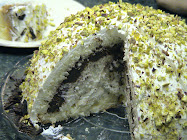 I would never have known that Martha of Bethany was a dragon slayer. Such hagiographic details were not featured in my Mennonite Sunday school curriculum! That she’s the patron saint of cooks doesn’t surprise me (after all, I did learn that she fed and housed Jesus) but a dragon slayer? It never crossed my mind; not until I came across the original 1931 edition of Joy of Cooking, the front cover of which features a stylized cut out of this redoubtable saint subduing the dragon Tarasconus.
I would never have known that Martha of Bethany was a dragon slayer. Such hagiographic details were not featured in my Mennonite Sunday school curriculum! That she’s the patron saint of cooks doesn’t surprise me (after all, I did learn that she fed and housed Jesus) but a dragon slayer? It never crossed my mind; not until I came across the original 1931 edition of Joy of Cooking, the front cover of which features a stylized cut out of this redoubtable saint subduing the dragon Tarasconus.
When I first saw the black, blue and green image with its trinity of purse, mop and dinner plate, I asked myself, “dragons in the culinary world? Who needs the aid of a dragon slayer when you’ve got a kitchen?” But further investigation revealed that Irma S. Rombauer faced formidable dragons as she compiled and wrote Joy. Only a year before Rombauer began working on her cookbook her husband committed suicide. Navigating her way through such grief and in doing so producing one of the most influential English cookbooks in the world is definitely dragon slaying activity.
But what of my dragons? As I cast about through the decades of my cooking, I could find none. My culinary life has advanced apace from when I first made unbaked cookies from the Five Roses Cookbook at age eight to now. I’ve had a few bumps, like adding rice to those cookies instead of coconut, some setbacks—I’ve never been able to make Chelsea buns to my satisfaction—but I could find nothing that approximated a dragon. But as my mind wandered back to St. Martha, I wondered what else she had kept at bay in that wood along the River Rhone between Arles and Avignon. Might there not have been other ophidian terrors a-slither that she repelled with her centenary of daily prayers. Perhaps, I thought, Martha has not so much slain my culinary dragons as warded them off
 before they reached me. What if, I asked myself, I had come from a family that cared little about food; that couldn’t, or worse, didn’t care to differentiate between kraft dinner and the homemade Bothwell cheese sauce that slathered the macaroni we ate? What if food—stories of food, preparation of food, production of food, consumption of food—hadn’t been an enduringly ubiqui
before they reached me. What if, I asked myself, I had come from a family that cared little about food; that couldn’t, or worse, didn’t care to differentiate between kraft dinner and the homemade Bothwell cheese sauce that slathered the macaroni we ate? What if food—stories of food, preparation of food, production of food, consumption of food—hadn’t been an enduringly ubiqui tous presence in my family, an ethos that continually enveloped me? The culture of food in which I was formed is without a doubt the bedrock on which I have cultivated my cookery. A life without it is a thought too dragonesque to contemplate!
tous presence in my family, an ethos that continually enveloped me? The culture of food in which I was formed is without a doubt the bedrock on which I have cultivated my cookery. A life without it is a thought too dragonesque to contemplate!Thank you St. Martha.
(A word on images. The first image is "Christ in the House of Mary and Martha" by Vincenzo Campi. The bottom two? I don't know their provenance other than the internet.)















































2 comments:
I love the four versions of Martha pictured in your blog, none remotely like the Martha of my Sunday School classes
I don't think these versions of Martha would have gone over too well!
Post a Comment